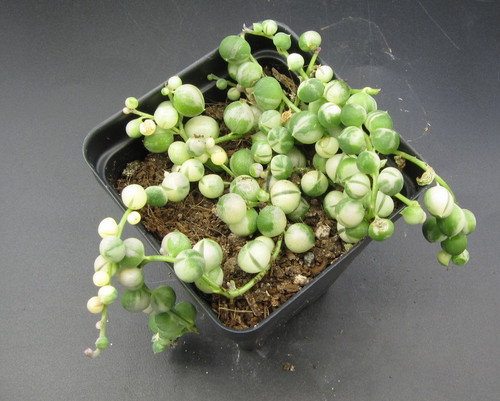Pot Size: 2.5"
Accepted Scientific Name:
Senecio rowleyanus
Origin and Habitat
Senecio rowleyanus, commonly known as String of Pearls, is native to the arid and semi-arid regions of southwest Africa, particularly Namibia. In its natural environment, it trails along the ground or hangs over rocky ledges, using its nearly spherical leaves to store water and survive in extremely dry climates. The plant thrives in sandy, well-draining soil with limited rainfall and high light intensity. Adapted to drought and intense sun, Senecio rowleyanus has evolved a unique bead-like leaf shape to minimize water loss while maximizing efficiency in photosynthesis.
Description
Senecio rowleyanus produces long, trailing stems up to 36 inches in length, lined with small, pea-shaped green leaves about ¼ inch in diameter. These distinctive, spherical leaves resemble pearls and often have a faint translucent line that allows light to penetrate deeper into the plant. In summer or under the right conditions, it blooms with tiny white flowers that resemble miniature daisies and emit a faint cinnamon-like fragrance. Its graceful, cascading form makes it highly desirable for hanging baskets and shelf-top containers.
Cultivation
Zone USDA Zones 9–11
Temperature Optimal temperature range is 18°C to 27°C; protect from cold below 5°C
Growth Rate Fast-growing under warm temperatures and bright light
Soil Use a porous succulent mix with added pumice to ensure fast drainage and prevent water retention
Watering Water thoroughly but infrequently. Allow soil to completely dry out between waterings. Water less in winter
Fertilizing Apply a diluted, balanced fertilizer every 2–3 weeks during spring and summer for best growth
Light Prefers bright, indirect sunlight indoors or filtered light outdoors. Avoid harsh midday sun to prevent scorching
Pests and Diseases Susceptible to mealybugs and aphids. Overwatering may cause root rot. Ensure good airflow to avoid fungal problems
Propagation
Propagated easily by stem cuttings. Simply lay cut stems on well-drained pumice-rich soil; roots will develop at leaf nodes.



